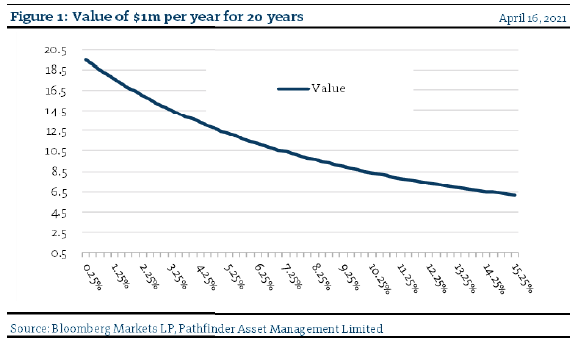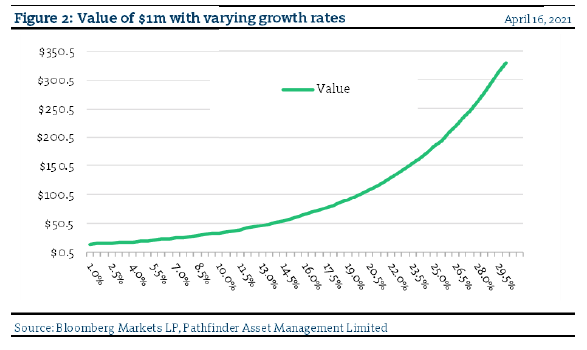Inflation Asset Strategy
We concluded last week that, as the volatility in certain sectors of the stock market increases due to changing inflation expectations, we would add good quality, growing free cash flow companies to the portfolio. As regular readers of the Investment Outlook know, as investors, we focus on buying companies that generate growing cash flow after the costs of maintaining the exiting business is considered (i.e. free cash flow). Ideally, we can purchase that cash flow at a discount to what other investors believe the future cash flows to be worth. Over time, a good quality growing company purchased at a discount can be held for the very long-term as the company evolves into our investment thesis. We also believe that the company will eventually be recognized by other investors, resulting in a price increase in the shares that trade on a stock market and represent a fractional ownership in the businesses.
- Figure 1 presents the $1 million per year cash flow stream discounted at different levels for inflation. When we consider the cash flow that we are purchasing, we must consider the level of inflation that we experience over the holding period of the investment. As you can see, the higher the level of inflation, the lower we would value the cash flow steam in today’s dollars. This is why the investment community has recently been so concerned about the level of interest rates, which include inflation expectations. Higher interest rates clearly impact the value of future cash flows and investors react accordingly to the changes.

- Figure 2 presents the same concept but instead holds the inflation rate stable at 4% (pretty high!) but assumes different growth rates for the cash flow (0-30%). This is a serious consideration because a bond, which has no cash flow growth, would be worth significantly less than a company that can grow its cash flow at say 20% a year.

“This means that” as our view on the future level of inflation changes, we consider different types of assets more or less valuable. Bond-like assets, for example, in a rising inflationary environment will be worth less. This would be true also of equities that have regulated cash flows (i.e. utilities) or that have their cash flow assumed to be far in the future (i.e. new technology companies). We will write more about other companies that might benefit in this environment next week.
National Instrument 31-103 requires registered firms to disclose information that a reasonable investor would expect to know, including any material conflicts with the firm or its representatives. Doug Johnson and/or Pathfinder Asset Management Limited are an insider of companies periodically mentioned in this report. Please visit www.paml.ca for full disclosures.
*All returns are time weighted and net of investment management fees. Returns from the Pathfinder Partners’ Fund and Pathfinder Real Fund are presented based on the masters series of each fund. The Pathfinder North American Equity Portfolio and The Pathfinder North American Income Portfolio are live accounts. These are actual accounts owned by the Pathfinder Chairman (Equity) and client (High Income) which contain no legacy positions, cash flows or other Pathfinder investment mandates or products. Monthly inception dates for each fund and portfolio are as follows: Pathfinder North American Equity Portfolio (January 2011), Pathfinder North American High-Income Portfolio (October 2012) Pathfinder Partners’ Fund (April 2011), Pathfinder Real Fund (April, 2013), and Pathfinder International Fund (November 2014).
Pathfinder Asset Management Limited (PAML) and its affiliates may collectively beneficially own in excess of 10% of one or more classes of the issued and outstanding equity securities mentioned in this newsletter. This publication is intended only to convey information. It is not to be construed as an investment guide or as an offer or solicitation of an offer to buy or sell any of the securities mentioned in it. The author has taken all usual and reasonable precautions to determine that the information contained in this publication has been obtained from sources believed to be reliable and that the procedures used to summarize and analyze such information are based on approved practices and principles in the investment industry. However, the market forces underlying investment value are subject to sudden and dramatic changes and data availability varies from one moment to the next. Consequently, neither the author nor PAML can make any warranty as to the accuracy or completeness of information, analysis or views contained in this publication or their usefulness or suitability in any particular circumstance. You should not undertake any investment or portfolio assessment or other transaction on the basis of this publication, but should first consult your portfolio manager, who can assess all relevant particulars of any proposed investment or transaction. PAML and the author accept no liability of any kind whatsoever or any damages or losses incurred by you as a result of reliance upon or use of this publication.